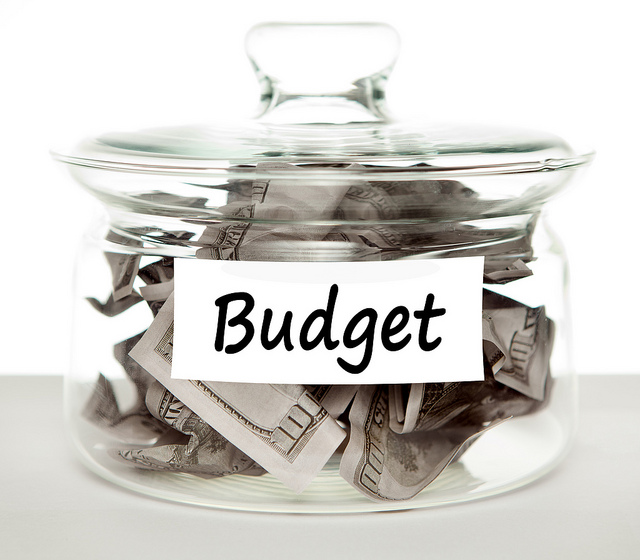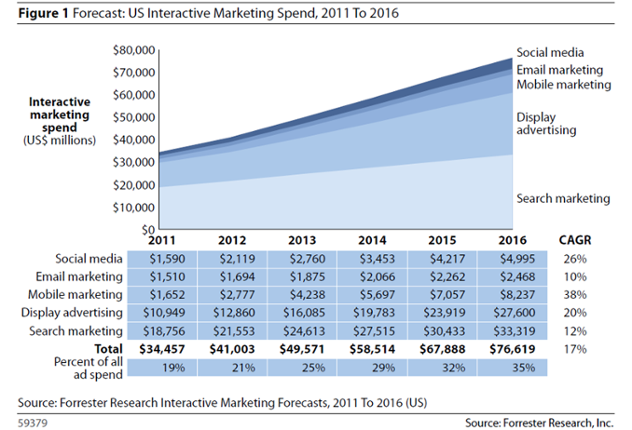The question on the minds of many when it comes to creating a digital marketing budget is “what should be included in my digital marketing budget?”. This is a very legitimate question, especially if you’re to consider what so many statistics are showing us concerning budgeting across various segments and how they tend to fluctuate in prominence.
For example, statistics from Forester Research Interactive Marketing Forcast (US) shows how email and social media received just about the same amount of % of digital marketing dollars in 2011 and email was quickly getting significantly lesser fast forward to 2016. Another statistics (forecasting 2014-2019) by the same firm shows how mobile(a relatively new, and also the fastest growing medium) was taking up bigger chunks of the %, only ranking below display advertising and search marketing.
With so much changing so fast, a practitioner without so much experience in digital marketing might get easily confused on what marketing channels/tactics to include in their budget and which ones to ignore totally. To know my take on this, find out in this blog post.
First and foremost, its important to let you know that this article is not going to be delving into the intricate details of what % of your dollars to go to what channels. This is just going to be providing a non-exhaustive view on what channels and digital marketing tactics should take prominence and, if necessary, which ones should be stripped off your budget totally.
#1. Content Marketing
How much of your digital marketing budget is allocated to content marketing this year? If you’re thinking of creating a digital marketing budget that will make an impact on your bottom line, you better plan your digital marketing to include content marketing.
Most companies fail to make proper appropriation for content marketing from the onset, and then end up scrambling for resources to help meet up with the demands or keep up with the competition. Your digital marketing budget should first of all take care of content marketing.
How much of your spending dollars should go to content marketing? You can find out a more precise figure by analyzing what you spent the previous year, the number of adjustments you add to make over the course of the budget period and how much gap was left uncovered.
If you’ve not previously done any budgeting for content marketing, then below is a simple list of what your content marketing will cover:
- Graphics: This includes the design, creative, brainstorming and research. If a different party will be handling the different aspect of creating graphics for your content marketing needs, then your budget must fully account for that.
- Blog posts: Since we’re talking digital marketing here, certainly, your content marketing will involve creating articles for your company blog. You might even go as far as using guest posting to complement your blog posts. Who will be handling these tasks? Will it be done in-house and the cost covered under the salaries of your employees or will you prefer to outsource it to professionals? Your budget should reflect your decision on this.
- Video Content: Every form of content you create to be used by means of publishing on any medium, either external or internal, should be considered as content marketing
How do you plan to drive traffic to all the content forms you’ve created? Your content marketing is not complete if the marketing aspect of it is not taken care of. If you’re considering a separate ads spend for each content you create, will this be reflected in your budget?
- Distribution: One effective means of content marketing is content distribution. This will more likely than not, cost you some change. There are 3 major ways content distribution works: Earned Content Distribution, Owned Content Distribution and Paid Content Distribution. As you might have guessed, paid content distribution will cost you dollars. But its not the only one that might cost you money, owned content distribution and, as a matter of fact, earned content distribution might cost you as well.
- Syndication: Syndication allows your content to be shown on a more popular outlet either for free or for an agreed cost. Services like Outbrain can make distributing and syndicating your content super easy.
- Content Upgrade: This is one form of content marketing that is guaranteed to help you turn your prospects into leads. The down side? It takes a lot of planning and effort to make it successful. Its an area you might need to tweak several times for you to make success or just hire a pro outright. Your decision should impact your budget.
#2. Social Media
I don’t think anyone would be planning a digital marketing budget without including social media. On a scale of importance, many would have me place search marketing over social media, but with recent statistics showing that social media is overtaking search in referral traffic, I don’t see why this shouldn’t be the case.
In a Forbes post published on Feburary of 2015, it was reported that social media now drives 31% of all referral traffic; a Fortune article published on August of the same year reported that Facebook now drives more traffic to media sites than Google. Remember, Google is the de facto search engine as of date.
With statistics showing that social media is the #1 source of referral traffic, it’s only expedient to place more importance on it when it comes to your digital marketing budget.
If you’re thinking of what major social networking and sharing sites you should pay the most attention to in 2016, consider the following:
- Snapchat
#3. Search Marketing
Search marketing is the most “complex” aspect of digital marketing. It is also a medium that drives the most targeted form of traffic to websites. This is due to the fact that whomever is doing a search for any term related to your offering is near the purchase circle than other prospects you’ll get from, say, social media or direct traffic.
Search marketing can be broken into two major forms: organic and paid search. Getting either of them right takes a lot of understanding and tinkering which most do not have the expertise or patience for. Which is why you need to allocate a significant amount of your budget for it.
- Organic search: This includes optimizing your website to rank for organic (non-paid) traffic from search engines. It includes using methods such as link building, content and keyword optimization to gain an advantage on search result pages (SERP)
- Paid search: the clicks you get to your website by being a Google adwords client, which gets your website displayed on Google search result pages.
#4. Marketing Automation
In 2016 and beyond, businesses should take automation more seriously than in 2015. From the software that retains your leads to the ones that will handle and streamline the sales transaction, there’s an abundance of automation software in the market for you.
Automation will determine whether your sales team can get the extra hours to convert other leads or would spend their whole efforts just trying to convert a single unprofitable lead. These tools might cost you money, but the value you’ll get from them will pay for so many other things.
#5. Mobile Marketing
For many businesses, given that mobile is now getting bigger and bigger, and as I shared with you above, it’s already overtaken desktop, there is the tendency to allocate more budget to mobile marketing than any other medium.
The requirements for a successful mobile marketing strategy starts with the design and compatibility of the website itself. Google, as a measure to encourage more websites to become adaptable to various screens, with a core focus on mobile, started penalizing non-compatible websites in 2015.
If your company’s website is not using a responsive design yet, you might also want to include the cost for that in your mobile marketing budget? Another place you could accommodate this would be in the design, but I’m assuming you are not focusing much on design here.
#6. Display Advertising
Display advertising should not be taking too much of your marketing budget as prospects are increasingly become biased towards display ads. The bottom line is display ads are no more as effective as they used to be. So you might just want to spend less in this area.
But, for the purpose of creating brand awareness and recognition, you should include display ads in your digital marketing budget.
#7. Email Marketing
Email is still the medium that gives you the least restriction when it comes to how often and how much of your leads you want to reach. It has taken a significant position on many marketers’ ladder since when email became a marketing medium.
Brands use webinars, events, content and case studies to engage their leads. And it’s also very effective at promoting your products and services, or creating buzz and traffic for your website activities.
#8. Ads and Retargeting/Remarketing
In marketing, some of your customers will need to see your brand or products several times before they decide they’re going to become your clients. This is where remarketing or retargeting comes in. Facebook was first to introduce retargeting in 2013. The same program was launched for mobile in 2014.
Retargeting is very effective because it is targeted only to those who have had contact with your brand either by visiting your website once or by using an app by your company.
How important is ads retargeting? Going by stats, just 2% of visitors to your website will make a purchase on first visit. The other 98% will remain window shoppers (they’ll look around your products and services but will leave your website once they get to the purchase page). Retargeting will help keep your brand fresh on the mind of these 98% and attempt to bring them back to your website.
Should you include this in your budget? Yes.
#9. Link Building
Link building is essential for SEO. If you’re expecting your search marketing effort to yield, building backlinks to your website is critical. For this sake, your digital marketing should specifically cater to accommodate link building.
Link building is the most difficult aspect of organic search. This is because it involves dealing with people, who are increasingly becoming weary of linking to other websites. A pro might find doing this very easy, simply because they’ve been doing it for a while. The downside is whomever knows their onions charge a lot for link building.
Link building methods like guest blogging, broken link building etc take so much effort to be successful.
Conclusion
If you find that creating a budget for your digital marketing campaign is difficult, you can hire an expert to help you iron it out. But these are just the basic things your digital marketing budget should take care of. If you find this blog post helpful, don’t forget to share it.
Featured image via taxcredits.net
Stats image credit Forrester Research Inc.



1 thought on “What Your Digital Marketing Budget Should Be Made of”